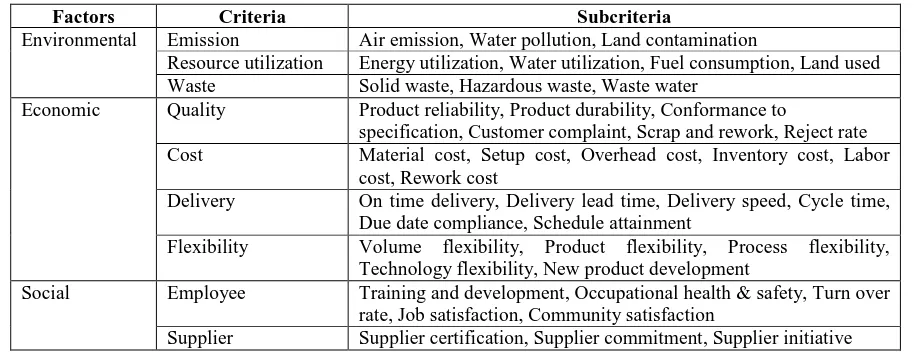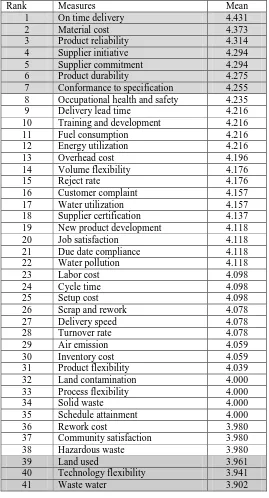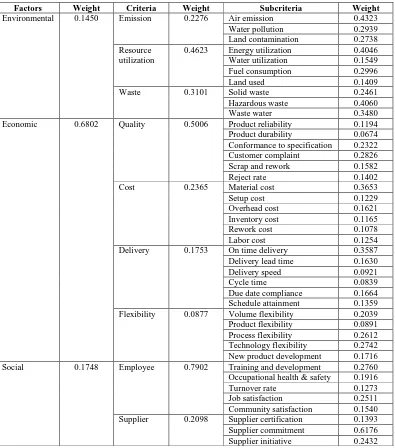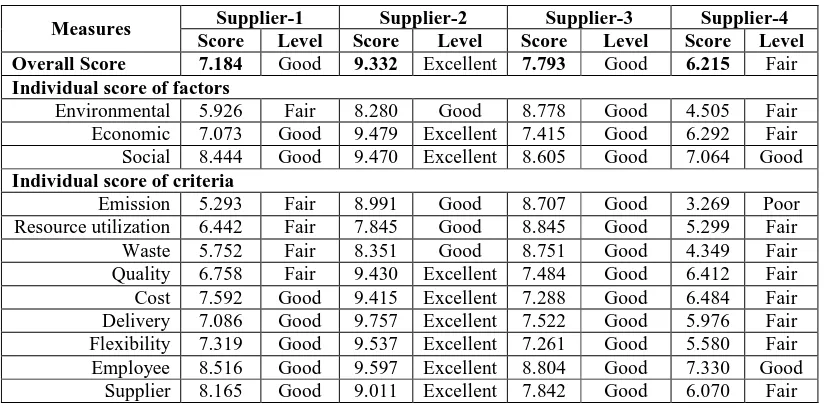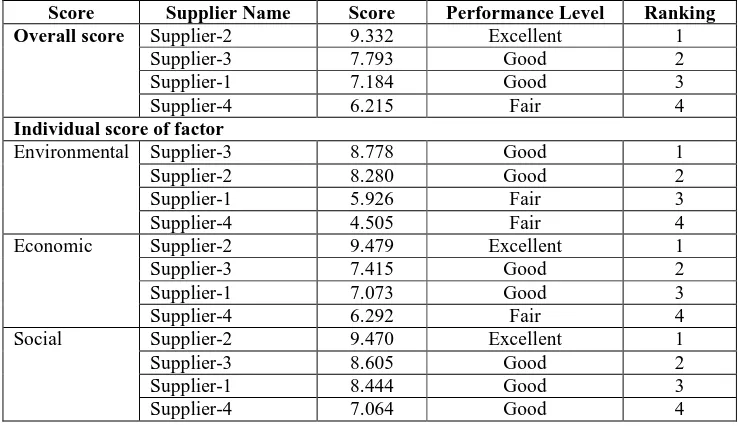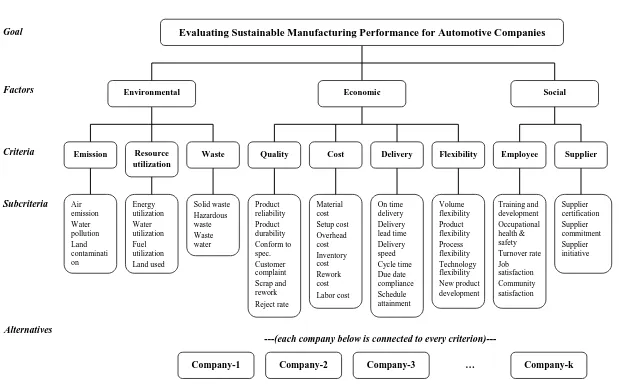Follow @isahp2016
ISAHP2016 | Past Proceedings http://www.isahp.org/proceedings/symposium/?year=2013&page=copy...
AN AHP BASED-MODEL FOR SUSTAINABLE MANUFACTURING
PERFORMANCE EVALUATION IN AUTOMOTIVE INDUSTRY
Elita Amrina
∗
Department of Industrial Engineering
Andalas University
Padang, Indonesia
E-mail: [email protected]
Sha’ri Mohd Yusof
Department of Manufacturing and Industrial Engineering
Universiti Teknologi Malaysia
Johor, Malaysia
E-mail: [email protected]
ABSTRACT
Sustainable manufacturing has become a critical issue for industries worldwide. In order to survive in today's competitive business environment, adopting sustainable manufacturing practices has become a necessity. A performance evaluation system is crucial for achieving a successful sustainable manufacturing in the automotive industry. Hence, an AHP based-model for sustainable manufacturing performance evaluation was developed in this study. Firstly, a set of initial key performance measures for sustainable manufacturing evaluation has been identified and derived from the literature. The measures were developed based on the triple bottom line of sustainability of environmental, economic, and social, consisting of nine criteria and further divided into a total of 41 subcriteria. Secondly, a survey was conducted to confirm the adaptability of the initial measures with industry practices. The results indicated that all the initial measures are highly important and thus proposed as the key performance measures of sustainable manufacturing evaluation for automotive industry. Finally, Analytic Hierarchy Process (AHP) is applied to sustainable manufacturing performance evaluation based on the measures. Relative importance weight of all the measures is determined by summarizing the opinions of experts. Quality and cost were found to be the top two important measures in evaluating sustainable manufacturing performance, while emission and supplier were the least important measures. It indicated that the automotive industry is still focusing more on the economic factor. The proposed model was then evaluated using a case study company from the automotive industry. The results show the existing performance level on strengths and weaknesses and provide directions for companies to take appropriate actions in improving their performance. It is hoped that the model enables and assists automotive companies in achieving the higher performance and so as increasing the competitiveness.
Keywords: AHP, evaluation, measures, sustainable manufacturing
1. Introduction
The increasing concerns to sustainability driven by legislation, public interest, and competitive opportunity (Linton
et al., 2007) have forced manufacturing companies to consider sustainability into their strategies and activities.
Achieving sustainability in manufacturing activities have been recognized as a critical need due to diminishing non-renewable resources, stricter regulations related to environment and occupational safety, and increasing consumer preference for environmentally-friendly products (Jayal et al., 2010). The adoption of sustainable manufacturing offers companies a cost effective route to improve their economic, environmental, and social performance as the three pillars of sustainability (Pusavec et al., 2010). Companies that adopt sustainable practices are able to achieve better product quality, higher market-share, and increased profits (Nambiar, 2010). Therefore, developing sustainable manufacturing is becoming a critical global concern (Ijomah et al., 2007).
Proceedings of the International Symposium on the Analytic Hierarchy Process 2013
2
Sustainable manufacturing is certainly one of the critical issues for the automotive industry. The automotive industry has made remarkable positive contributions to the world economy and people’s mobility, but its products and processes are a significant source of environmental impact (Nunes and Bennett, 2010). The automotive industry constitutes a product system that directly and indirectly relates to economic wealth creation as well as impacts on the natural and human environment along all phases of the product life cycle (Warren et al., 2001). Thus, evaluating sustainable manufacturing performance has become a necessity for this industry.
This paper proposes an AHP based-model for sustainable manufacturing performance evaluation in automotive industry. A set of initial key performance measures for sustainable manufacturing evaluation was identified and derived from the literature based on the triple bottom line of sustainability of environmental, economic, and social. Then, a survey was conducted to confirm the adaptability of the initial measures with industry practices. Finally, Analytic Hierarchy Process (AHP) was applied to sustainable manufacturing performance evaluation based on the measures. The evaluation model enables and assists automotive companies to achieve the higher performance and increase the competitiveness.
2. Methodology
The methodology has three interrelated stages. First, the initial key performance measures for sustainable manufacturing evaluation were identified and derived from the literature. The initial measures were developed based on the triple bottom line of sustainability of environmental, economic, and social, and constructed by integrating the manufacturing performance measures and the sustainable manufacturing measures. Second, a survey through questionnaire was conducted to Malaysian automotive companies in order to confirm the adaptability of the initial measures with industry practices. Finally, a sustainable manufacturing performance evaluation based on the measures was developed using Analytic Hierarchy Process (AHP) methodology. The details are presented in the following sections.
2.1 Stage 1: Identification of key performance measures
This study starts with the development of initial key performance measures for sustainable manufacturing evaluation in automotive companies through literature review. The initial measures have been constructed by integrating the manufacturing performance measures and the sustainable manufacturing measures. The initial measures have adopted the triple bottom line of sustainability consisting of environmental, economic, and social performance factors. As a result, the initial measures consist of three factors divided into nine criteria and further divided into a total of 41 subcriteria were identified as shown in Table I.
Table 1. Initial key performance measures for sustainable manufacturing evaluation
Factors Criteria Subcriteria
Environmental Emission Air emission, Water pollution, Land contamination
Resource utilization Energy utilization, Water utilization, Fuel consumption, Land used
Waste Solid waste, Hazardous waste, Waste water
Economic Quality Product reliability, Product durability, Conformance to
specification, Customer complaint, Scrap and rework, Reject rate Cost Material cost, Setup cost, Overhead cost, Inventory cost, Labor
cost, Rework cost
Delivery On time delivery, Delivery lead time, Delivery speed, Cycle time, Due date compliance, Schedule attainment
Flexibility Volume flexibility, Product flexibility, Process flexibility, Technology flexibility, New product development
Social Employee Training and development, Occupational health & safety, Turn over rate, Job satisfaction, Community satisfaction
Elita Amrina and Sha’ri Mohd Yusof/ An AHP based-model for sustainable manufacturing performance evaluation in automotive industry
3 2.2 Stage 2: Conducting industry survey
In order to validate the initial measures, a survey was conducted to automotive companies which manufacture parts and accessories for motor vehicles and their engines listed in Proton Vendor Association (PVA) directory year 2010. Of the 118 questionnaires mailed, a total of 54 responses were received. Three of the responses were not useable due to incomplete answer, resulting in a response rate of 43.2 percent. The respondents were asked to rate the importance level of each measure of sustainable manufacturing evaluation in their companies. A five-point scale ranging from 1 (not important at all) to 5 (very important) was used to rate the perspective of respondents to the importance level of the performance measures. The mean importance values ranged from 3.902 to 4.431 as presented in Table 2.
Table 2. Mean important level of the initial measures for sustainable manufacturing evaluation
Rank Measures Mean
1 On time delivery 4.431
2 Material cost 4.373
3 Product reliability 4.314
4 Supplier initiative 4.294
5 Supplier commitment 4.294
6 Product durability 4.275
7 Conformance to specification 4.255
8 Occupational health and safety 4.235
9 Delivery lead time 4.216
10 Training and development 4.216
11 Fuel consumption 4.216
12 Energy utilization 4.216
13 Overhead cost 4.196
14 Volume flexibility 4.176
15 Reject rate 4.176
16 Customer complaint 4.157
17 Water utilization 4.157
18 Supplier certification 4.137
19 New product development 4.118
20 Job satisfaction 4.118
21 Due date compliance 4.118
22 Water pollution 4.118
23 Labor cost 4.098
24 Cycle time 4.098
25 Setup cost 4.098
26 Scrap and rework 4.078
27 Delivery speed 4.078
28 Turnover rate 4.078
29 Air emission 4.059
30 Inventory cost 4.059
31 Product flexibility 4.039
32 Land contamination 4.000
33 Process flexibility 4.000
34 Solid waste 4.000
35 Schedule attainment 4.000
36 Rework cost 3.980
37 Community satisfaction 3.980
38 Hazardous waste 3.980
39 Land used 3.961
40 Technology flexibility 3.941
Proceedings of the International Symposium on the Analytic Hierarchy Process 2013
4
From the table, it can be seen that on time delivery had the highest value of 4.431. This is followed by material cost with importance mean of 4.373. The next sequences of importance are product reliability, supplier initiative, supplier commitment, product durability, and conformance to specification with importance mean of 4.314, 4.294, 4.294, 4.275, and 4.255 respectively. Those top measures included in the criteria of delivery, cost, quality, and supplier; and the factors of economic and social. On the other hand, land used, technology flexibility, and waste water, were ranked the least important, but their mean values are at an importance level. Therefore, it can be concluded from the results that all the initial measures are perceived at high important level, and thus, three factors with a total of nine criteria and 41 subcriteria have been proposed as the key performance measures for sustainable manufacturing evaluation in automotive companies.
2.3 Stage 3: Developing sustainable manufacturing performance evaluation model
An evaluation model for sustainable manufacturing performance in automotive industry was developed based on the proposed measures. Analytic Hierarchy Process (AHP) methodology was applied in the developing of the model consisting of constructing the hierarchy, calculating the relative weight, rating the measures, and computing the scores of companies, and ranking the companies. Details are given in the following section.
3. Development of sustainable manufacturing performance evaluation model
Analytic Hierarchy Process (AHP) first introduced by Thomas L. Saaty in 1971 has become one of the most widely used methods for multiple criteria decision making (MCDM) problems. It is a decision approach designed to aid in making the solution of complex multiple criteria problems to a number of application domains (Saaty, 2008). It has been known as an essential tool for both practitioner and academics to conduct researches in decisions making and examining management theories (Cheng et al., 2002). AHP as a problem solving method is flexible and systematic that can represent the elements of a complex problem (Chan et al., 2006). Cheng et al. (2002) pointed out several benefits of AHP methodology. First, it helps to decompose an unstructured problem into a rational decision hierarchy. Second, it can elicit more information from the experts or decision makers by employing the pair-wise comparison of individual groups of elements. Third, it sets the computations to assign weights to the elements. Fourth, it uses the consistency measure to validate the consistency of the rating from the experts and decision makers. The following steps show the development of an AHP-based model for sustainable manufacturing performance evaluation in automotive companies.
3.1 Construct the hierarchy
The proposed key sustainable manufacturing performance measures are used in constructing a hierarchy. The five groups were defined and constructed in the hierarchy including goal, factors, criteria, subcriteria, and alternatives. In the hierarchy, evaluating sustainable manufacturing performance is set to be the goal. The next level consists of three factors of environmental, economic, and social. At the third level, there are nine criteria of emission, resource utilization, waste, quality, cost, delivery, flexibility, employee, and supplier. The fourth level consists of the subcriteria that described each of criteria with a total of 41 subcriteria. Finally, the alternatives that the decision maker needs to evaluate are presented at the bottom of the hierarchy consisting of the companies to be assessed and compared. The overall hierarchy is depicted in Figure 1 as shown in Appendix 1.
3.2 Calculate the relative weight
Once the hierarchy has been constructed, the importance weight of the measures should be calculated. For that purpose, the Analytic Hierarchy Process (AHP) methodology was applied. AHP methodology was utilized to determine the importance weights of sustainable manufacturing performance measures. A pairwise comparison questionnaire was then designed and mailed to thirteen senior managers from the automotive companies in Malaysia. Those managers were carefully selected based on their experience in automotive industry. A total of 10 responses were received. The Consistency Ratio (CR) was used to check the consistency of the pairwise comparisons for each expert. The CR values are less than 0.1 which means it matches the consistency test. If it is not yet consistent, the comparison has to be repeated again.
Elita Amrina and Sha’ri Mohd Yusof/ An AHP based-model for sustainable manufacturing performance evaluation in automotive industry
5
are within the acceptable level recommended by Saaty (2008). It indicates that the experts have assigned their preferences consistently in determining the importance weights of the measures to evaluate sustainable manufacturing performance in automotive companies. Table 3 presents a summary of the result of the importance weights of the sustainable manufacturing performance measures. The importance weights show the importance value of one measure over another measure. In term of factors, economic is the most important factor with an importance value of 68.02%. Resource utilization (46.23%) is regarded to the highest important dimension to environmental performance. With regard to economic performance, quality is the most important dimension with an importance value of 50.06% over another. Employee (79.02%) is considered much more important dimension than suppliers to social performance.
Table 3. The importance weights of sustainable manufacturing performance measures
Factors Weight Criteria Weight Subcriteria Weight
Environmental 0.1450 Emission 0.2276 Air emission 0.4323
Water pollution 0.2939
Economic 0.6802 Quality 0.5006 Product reliability 0.1194
Product durability 0.0674
Delivery 0.1753 On time delivery 0.3587
Delivery lead time 0.1630
Delivery speed 0.0921
Cycle time 0.0839
Due date compliance 0.1664
Schedule attainment 0.1359
Flexibility 0.0877 Volume flexibility 0.2039
Product flexibility 0.0891
Process flexibility 0.2612
Technology flexibility 0.2742 New product development 0.1716
Social 0.1748 Employee 0.7902 Training and development 0.2760
Occupational health & safety 0.1916
Turnover rate 0.1273
Job satisfaction 0.2511
Community satisfaction 0.1540
Supplier 0.2098 Supplier certification 0.1393
Supplier commitment 0.6176
Supplier initiative 0.2432
Proceedings of the International Symposium on the Analytic Hierarchy Process 2013
6
3.3 Rating the sustainable manufacturing performance measures
The next step in evaluating the sustainable manufacturing performance is to rate the measures. In this study, a scale range from 1 to 10 (where 1 = highly poor, 2 = moderately poor, 3 = lowly poor, 4 = lowly fair, 5 = moderately fair, 6 = highly fair, 7 = lowly good, 8 = moderately good, 9 = highly poor, and 10 = excellent) was utilized to assess performance of each of the measures.
3.4 Computing the companies score
The next step is to compute the company score. The values generated from the performance rating are combined with the corresponding importance weights of the measures to obtain the company score. The company score is calculated for the overall score and as well as for individual score of each factor and each criteria. The overall score and individual score of each factor and each criterion of companies are then classified into four performance levels based on the following rules:
If 1 ≤ scores ≤ 4 then performance level is poor, If 4 < scores ≤ 7 then performance level is fair, If 7 < scores ≤ 9 then performance level is good, If scores > 9 then performance level is excellent.
3.5 Ranking the companies based on the score
The overall score and the individual score of factor and criteria of the companies evaluated are then ranked in descending order. The company with the highest score can be considered as attaining best practice.
4. Case study result
The proposed model has been applied to a case of automotive manufacturing company in Malaysia. The production managers were asked to evaluate their supplier using the 1 to 10 scale on each of 41 sustainable manufacturing performance measures. The rating values are used to calculate the company score consisting of the overall score and the individual score of each factor and each criterion. The overall score and individual score of each factor and each criteria of the companies compared are presented in a final result. The results of four suppliers compared are shown in Table 4. From the results, the company is able to know the performance level of their suppliers on their strengths and weaknesses.
Table 4. The scores of suppliers
Measures Supplier-1 Supplier-2 Supplier-3 Supplier-4
Score Level Score Level Score Level Score Level Overall Score 7.184 Good 9.332 Excellent 7.793 Good 6.215 Fair Individual score of factors
Environmental 5.926 Fair 8.280 Good 8.778 Good 4.505 Fair
Economic 7.073 Good 9.479 Excellent 7.415 Good 6.292 Fair
Social 8.444 Good 9.470 Excellent 8.605 Good 7.064 Good
Individual score of criteria
Emission 5.293 Fair 8.991 Good 8.707 Good 3.269 Poor
Resource utilization 6.442 Fair 7.845 Good 8.845 Good 5.299 Fair
Waste 5.752 Fair 8.351 Good 8.751 Good 4.349 Fair
Quality 6.758 Fair 9.430 Excellent 7.484 Good 6.412 Fair
Cost 7.592 Good 9.415 Excellent 7.288 Good 6.484 Fair
Delivery 7.086 Good 9.757 Excellent 7.522 Good 5.976 Fair
Flexibility 7.319 Good 9.537 Excellent 7.261 Good 5.580 Fair
Employee 8.516 Good 9.597 Excellent 8.804 Good 7.330 Good
Elita Amrina and Sha’ri Mohd Yusof/ An AHP based-model for sustainable manufacturing performance evaluation in automotive industry
7
Those scores are then used to rank the sustainable manufacturing performance of each supplier relative to others. The suppliers ranking for overall score and individual score of factor are shown in Table 5. It can be seen from the table, supplier-2 is at the highest for the overall score with a total score of 9.332 and performance level of excellent.
Table 5. Ranking of overall score and individual factor score of companies
Score Supplier Name Score Performance Level Ranking
Overall score Supplier-2 9.332 Excellent 1
Supplier-3 7.793 Good 2
Supplier-1 7.184 Good 3
Supplier-4 6.215 Fair 4
Individual score of factor
Environmental Supplier-3 8.778 Good 1
Supplier-2 8.280 Good 2
Supplier-1 5.926 Fair 3
Supplier-4 4.505 Fair 4
Economic Supplier-2 9.479 Excellent 1
Supplier-3 7.415 Good 2
Supplier-1 7.073 Good 3
Supplier-4 6.292 Fair 4
Social Supplier-2 9.470 Excellent 1
Supplier-3 8.605 Good 2
Supplier-1 8.444 Good 3
Supplier-4 7.064 Good 4
The ranking and performance level of companies obtained are quite varied. It can be seen that supplier-2 has attained the highest score on factors of economic and social, but at the second rank of environmental factor with a score of 8.280 and performance level of good. The top rank for environmental factor is company-3 with a score of 8.778 and performance level of good. It can be seen from the results that the company with the highest overall score might be not the best in all the factors. In order to make a quality decision making, these things need to be viewed in detail to prioritize the company’s performance criteria when evaluating sustainable manufacturing performance level.
5. Conclusions
This paper has presented the development of an AHP-based model for sustainable manufacturing performance evaluation in automotive companies. The tool was developed using Analytic Hierarchy Process (AHP) methodology. The hierarchy structure was established based on the proposed key measures of sustainable manufacturing performance evaluation for automotive companies. Then, the importance weights of the measures were assigned by pairwise comparisons and calculated using AHP methodology. Values of the measures were also rated using a scale of 1 (highly poor) to 10 (excellent). The company’s score was computed to assess sustainable manufacturing performance against the measures. Finally, the companies rank was determined based on their scores.
Proceedings of the International Symposium on the Analytic Hierarchy Process 2013
8
REFERENCES
Chan, F. T. S., Chan, H. K., Lau, H. C. W., and Ip, R. W. L. (2006). An AHP approach in benchmarking logistics performance of the postal industry. Benchmarking: An International Journal, 13(6), 636-661.
Cheng, E. W .L., Li, H., and Ho, D. C. K. (2002). Analytic Hierarchy Process: A defective tool when used improperly. Measuring Business Excellence, 6(4), 33-37.
Ijomah, W. L., McMahon, C. A., Hammond, G. P., and Newman, S. T. (2007). Development of design for remanufacturing guidelines to support sustainable manufacturing. Robotics and Computer-Integrated
Manufacturing, 23, 712–719.
Jayal, A. D., Badurdeen, F., Dillon Jr. O.W., and Jawahir, I. S. (2010). Sustainable manufacturing: modeling and optimization challenges at the product, process and system levels. CIRP Journal of Manufacturing Science and
Technology, 2(3), 144–152.
Linton, J. D., Klassen, R., and Jayaraman, V. (2007). Sustainable supply chains: an introduction. Journal of
Operations Management, 25(6), 1075–1082.
Nambiar, A. N. (2010). Challenges in sustainable manufacturing. Proceedings of the 2010 International Conference
on Industrial Engineering and Operations Management. January 9-10. Dhaka, Bangladesh, 1-6.
Nunes, B., and Bennett, D. (2010). Green operations initiatives in the automotive industry: an environmental reports analysis and benchmarking study. Benchmarking: An International Journal, 17(3), 396 – 420.
Pusavec, F., Krajnik, P., and Kopac, J. (2010). Transitioning to sustainable production – part I: application on machining technologies. Journal of Cleaner Production, 18, 174–184.
Saaty, T. L. (2008). The analytic hierarchy and analytic network measurement processes: application to decisions under risk. European Journal of Pure and Applied Mathematics, 1(1), 122-196.
Appendix 1
Figure 1. The hierarchy structure of sustainable manufacturing performance evaluation for automotive companies
Product
---(each company below is connected to every criterion)--- Alternatives
Emission Resource Waste
utilization
Cost Delivery Flexibility Employee Supplier
Quality
Environmental Economic Social
Evaluating Sustainable Manufacturing Performance for Automotive Companies
Air
Company-1 Company-2 Company-3 Company-k
